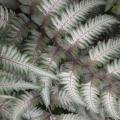Imagine the flickering flames of a fireplace or the copper blaze of a campfire, and you have the perfect picture of Japanese Shield Fern when her fronds first emerge. Lovely pumpkin-bronze fronds (11-28 inches tall and 5-14 inches broad) explode from the ground and when mature, turn a gratifying green hue.
Evergreen in mild climates, Japanese Shield Fern is a
dwarf fern, excellent for
borders and mass plantings where she is happy to control erosion. With her
slow to
moderate growth rate, she
tolerates drought drought, but prefers well drained, moist
humus-rich acidic soil.
You should know she will not tolerate heat or mid- to late-day sun, though morning sun is alright. Additionally, she will not put up with soil that is poorly draining, or packed hard. She will perform famously if planted in light, woodland shade on low mountains or hills. Japanese Shield Fern boasts
bipinnate fronds with 8-20 pairs of
pinnae.
In an otherwise shaded environment, Japanese Shield Fern becomes a lovely glow of warm rusty color shifting to a glimmering green later in season making her a true center-piece of any garden. Dryopteris erythrosora is a species of fern native to eastern Asia from China and Japan to the Philippines.
Things to Note If you live in a city where automobile pollution is high, you should not consider Japanese Shield Fern.
Gardener Tips Consider planting Japanese Shield Fern with clumps of
Black Mondo Grass for striking diversity in color resulting in a perennial shade rainbow. You will adore the results.
Performs best in well-drained (but moist) soil with added organic compost or peat moss. Best not to allow soil to dry out.
Will tolerate sun if given enough moisture.
Ferns have delicate foliage that often suffers during shipment and transplanting. Cut off any foliage that is broken, bent, brown or yellow - the plants will quickly recuperate with fresh growth. Bare root ferns are particularly prone to foliage loss, it is not uncommon to have to cut them off at ground level when transplanting. As long as the roots are firm they will recover, often showing new growth within weeks during warm months. If transplanting bare root ferns during warm weather they might not send up foliage until summer ends or the following spring (best to transplant bare root ferns when they are dormant: late fall to early spring).
General information that applies to all plants:
-
Ground
preparation, fertilization, pH
-
Planting
instructions
-
Explanation
and description of bare roots
-
How
to plant bare root plants
-
If you
cannot plant bare roots right away
 (0)
(0) Part sun
Part sun  Shade
Shade



